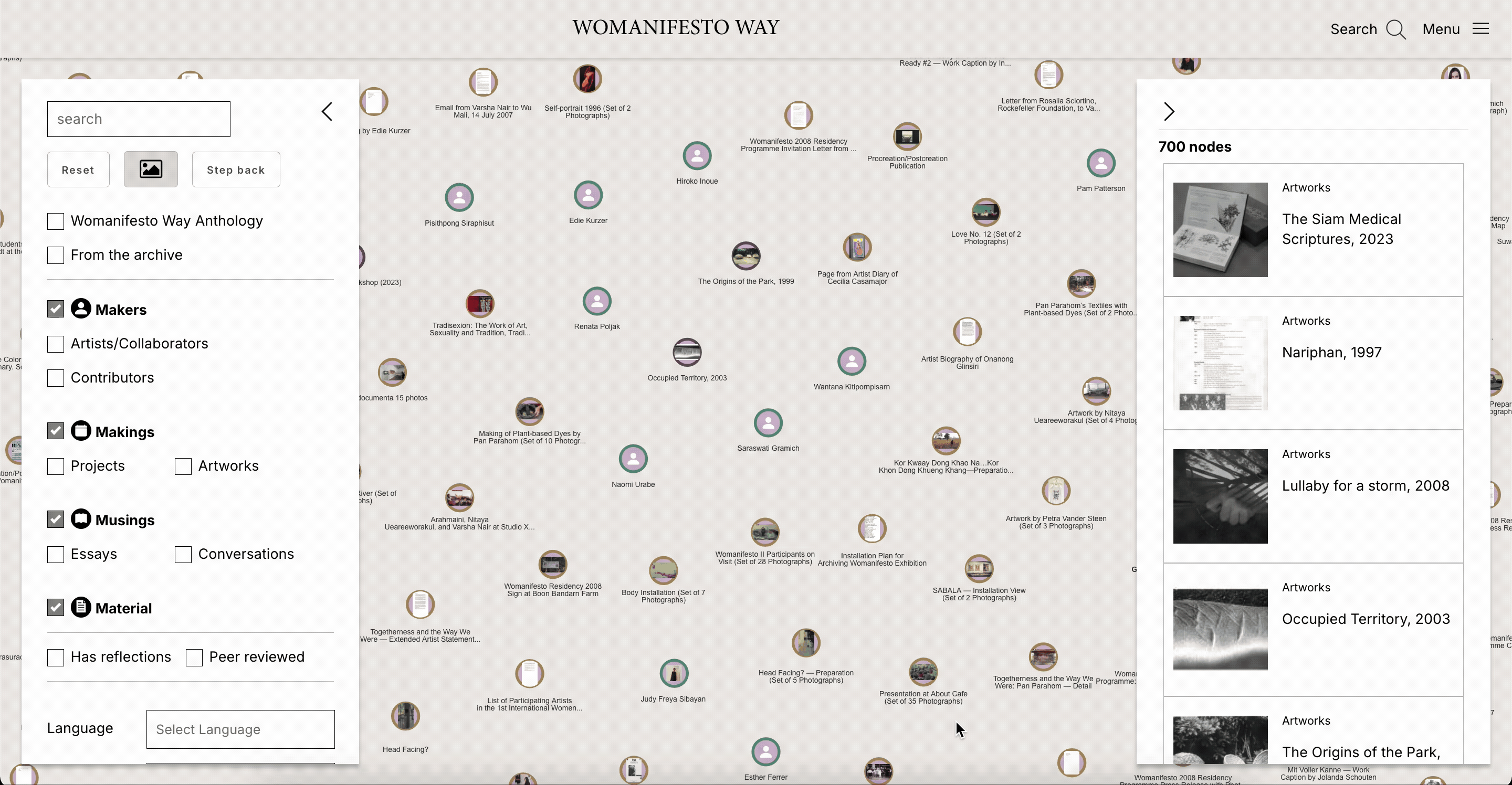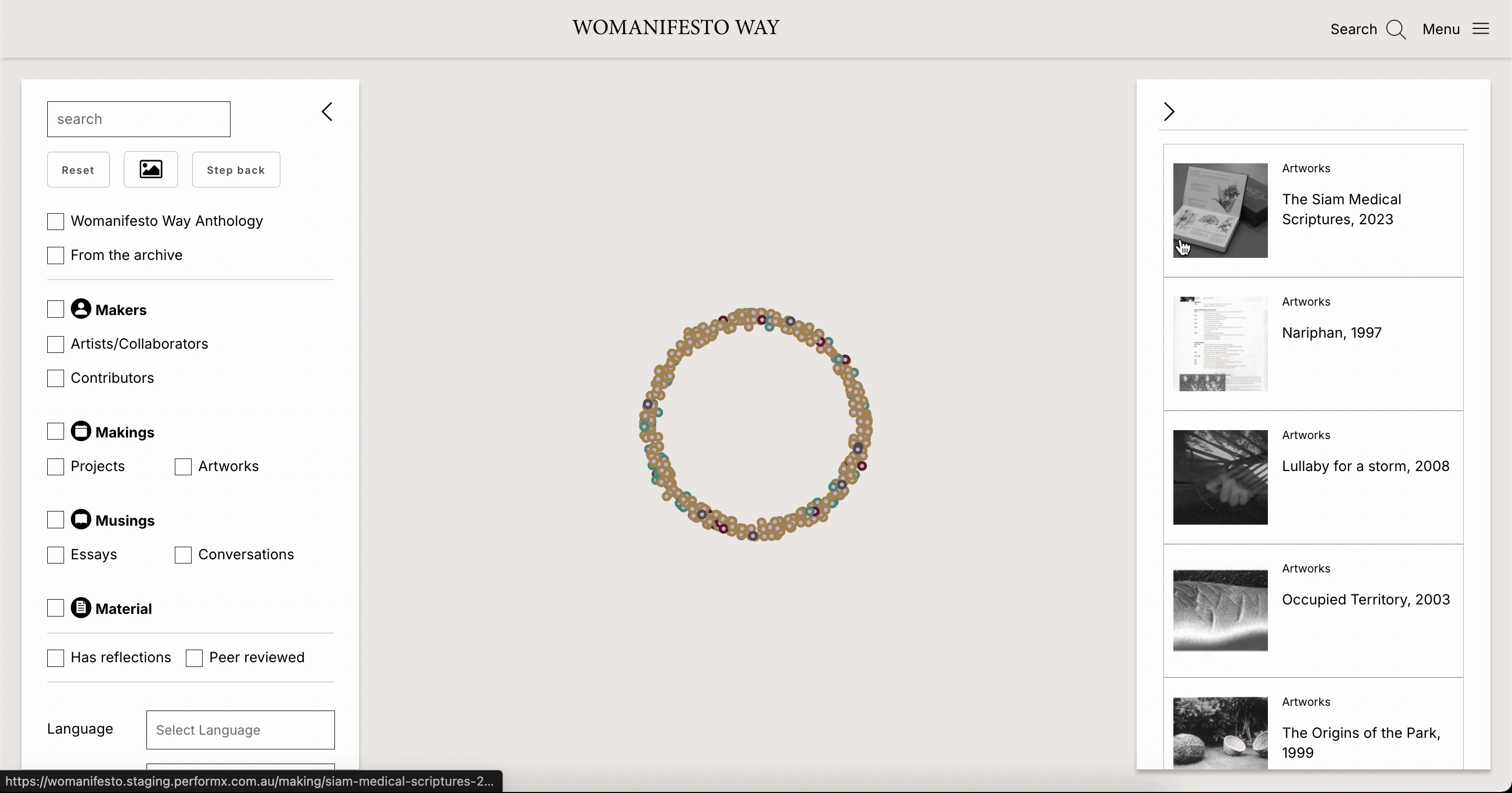Womanifesto Way is a digital project that combines an anthology and an archive.
The website has been designed to allow you to explore the content and encounter the histories and ideas in a range of different ways:
- As a visual repository for content, it presents as a series of nodes to find and pathways to take; and
- as a data interface, it offers itself as a dashboard for curating your experience, seeing patterns and making connections.
A range of recommended pathways and dashboard suggestions are outlined below.
Browse the Anthology
You can read, view, watch, and listen to a range of newly commissioned anthology content by selecting any node under the 'musings' category.
You can also select between 'essays', 'conversations' and 'recollections', which have been produced by artists, art historians, curators, and members of other collectives.
Recommended pathway: Explore by anthology content
Choose any node from the 'musings' category to be taken to newly commissioned essays, conversations, and artist reflections.
Once you've clicked on the node and deselected the 'musings' category, the projects, people, artworks and archival materials mentioned in that piece will appear as connected nodes for further exploration.

Dashboard suggestion: Filter to your preferred formats, languages and voices
Navigate the project's diverse mix of voices by filtering the nodes down to content published in particular languages, produced in particular media formats, or contributed by particular people.

Explore the Network Graph
The network graph can be explored in a variety of ways.
You can facet/filter the nodes down according to the main categories of 'makers', 'makings', 'musings' or 'materials', as well as by content-type sub-categories, such as 'projects', 'artworks', 'essays' and 'recollections'.
Click on any node to see its connections in the graph. Each connection will appear in the list of 'related pages' in the right sidebar.
Recommended pathway: Explore by projects
Browse Womanifesto's projects to see how their activities have developed over time from exhibitions and workshops to online gatherings and archival projects.
Each project is introduced by a brief overview compiled in collaboration with Womanifesto's organisers, with project nodes connecting up to their related artists, artworks, and archival materials for further exploration.

Dashboard suggestion: compare and connect via tags
Find connections across the network—these could be thematic, geographic, or material, for instance—by selecting and comparing tags.
Tags can reveal common interests between projects and people, or allow you to compare the prevalence of themes among the network over time.
Follow the connected pages
We hope the Womanifesto Way node graph is as much a discovery tool as it is a responsive interface for generating relational encounters.
At the node-based level the interface zooms in to centre the specific project, person, artwork, event, or document, surrounding them with their range of connections.
At this scale, you can navigate node-to-node based on looking at each node's image, title, and colour-coded border.
Recommended pathway: Explore by person
Choose someone from the 'makers' network to see what projects they've been a part of, any featured artworks by them, archival materials that relate to them, and any 'musings' in which they're mentioned.
Whether you visit a member of the Womanifesto collective (click on 'artists/collaborators') or a contributor to the Womanifesto Way anthology project (click on 'contributors), you can read a short biographical text that connects them to the project and the collective.

Dashboard suggestion: Switch to a full-screen image view
Nodes are illustrated with icons by default, but if you want to explore from node-to-node, you can switch to an image view and allow the associations to unfold.
For a closer view of the nodes and easier navigation between smaller networks, you can remove the left and right panels from view by clicking on the arrows.
See sources among contexts
We have partnered with Asia Art Archive to make the hundreds of digitised Womanifesto archival materials available as part of this anthology.
The Womanifesto Way enables you to research the collective's archive while seeing each source material directly connected to relevant people, projects, artworks, and anthology content.
Recommended pathway: Explore by materials
If you're interested in finding specific historical sources, you can click on the relevant project, person, event, or artwork and click on the 'materials' check box to see any archival records that relate to that node.
You can also filter the set of archival materials in multiple ways, by language, by media type, by tags, and to see any materials that have been responded to with a 'reflection' comment.

Dashboard suggestion: Explore visually by time
Use the time-slider to see how the network grows and develops from year to year between influxes of people, the frequency of projects, and the digitisation of archival materials.
Browse the Categories
Each of the main categories—'makers', 'makings', 'materials', and 'musings'—is also able to be navigated by a scrollable list of pages.
In keeping with the project's ethos, section themes have not been imposed on these lists and they have been presented non-hierarchically.
These are intended as static records of each category's pages, with the network graph as the primary means for navigation among the content.
Search the site
We have a simple keyword search available, just use the search box in the top right corner.
You might like to search for a particular person, event, artwork, project, or archival record;
or you might like to find your way to the relevant node by faceting your way through the selections in the left sidebar.
How to cite this website
Coming soon - our Anthology is currently under review so a final citation will be available once that project is complete.